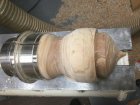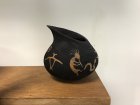I'm going to try out hollowing (using some Trent Bosch tools/rest) and have a couple of questions. Sorry for my ignorance, but we all were new at some point.
1. If you turn the type of vessel that seems to have a relatively small opening with kind of a live edge to it, after it dies and you've finished it, how do you go about removing the chuck tenon? With a bowl you can always use compression from the tail stock to hold it against a smaller turned piece in your chuck, turn down the tenon to a nub, then chisel/saw off the nub. But with the type of vessel I described, I have a hard time envisioning you compressing that small, uneven diameter of the opening to anything.
2. This could apply to a lot of turned objects, but if you're turning green wood to a thin finished state (1/8 to 1/4 inch) and you're planing to let it dry and likely warp to some degree, do most turners do a fair amount of sanding while it's still wet, or is it best to just wait until it's dry to do it all.
Thanks,
Grey
1. If you turn the type of vessel that seems to have a relatively small opening with kind of a live edge to it, after it dies and you've finished it, how do you go about removing the chuck tenon? With a bowl you can always use compression from the tail stock to hold it against a smaller turned piece in your chuck, turn down the tenon to a nub, then chisel/saw off the nub. But with the type of vessel I described, I have a hard time envisioning you compressing that small, uneven diameter of the opening to anything.
2. This could apply to a lot of turned objects, but if you're turning green wood to a thin finished state (1/8 to 1/4 inch) and you're planing to let it dry and likely warp to some degree, do most turners do a fair amount of sanding while it's still wet, or is it best to just wait until it's dry to do it all.
Thanks,
Grey






